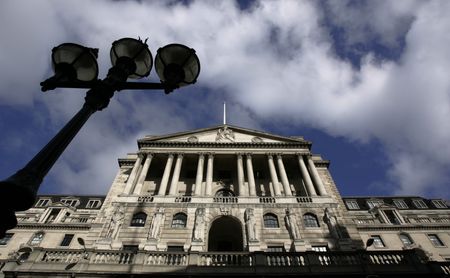LONDON (Reuters) -Major financial market participants expect the Bank of England’s interest rate rising cycle to come to an end in March next year, with rates peaking at 4.25%, up from 3.5% now, according to a survey which the central bank published on Friday.
The BoE carried out the survey of 60 major financial companies between Nov. 30 and Dec. 2, before Thursday’s announcement of a half-point rise in interest rates, its ninth hike since beginning to raise rates in December 2021.
The median expectation in the BoE survey is below the peak currently priced into financial markets which see rates peaking at 4.75% in August 2023. This difference may reflect how interest rate futures factor in the risk of an upward surprise in rates, as well as the most likely single outcome.
The BoE said on Thursday that it might need to make further increases in rates to be sure that double-digit inflation returns to target, as labour shortages are pushing up costs for businesses despite an incipient recession.
However, many economists focused on the split vote behind Thursday’s decision. Two policymakers opposed raising rates at all, and only one called for a repeat of November’s three-quarter-point rise.
Consumer price inflation hit a 41-year high of 11.1% in October, and market participants said they expected it to drop to 5.5% in a year’s time, 3% in two years and 2% in three years. – a slower return to target than the BoE has forecast.
Friday’s poll also showed that market participants expected the BoE to stick broadly to the 80 billion-pound ($97 billion)annual pace of reduction of its 830 billion-pound government bond stockpile, which the central bank announced in August.
However, they predict an increase in the pace to 90 billion pound between September 2024 and September 2025.
Ten-year gilt yields were forecast to rise to 3.5% by the end of June next year, before dropping back to 3.0% by the end of next year. Yields are 3.38% now, and were 3.1% just before the survey took place.
Sterling was seen little changed against both the dollar and the euro over the coming year.
($1 = 0.8211 pounds)
(Reporting by David MillikenEditing by William Schomberg)

